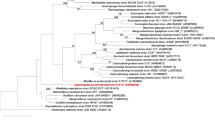Abstract
A bacterium coded as strain HAP-1 was isolated from a municipal anaerobic digestor for its ability to reduce >7000 ppm perchlorate in wastewaters. The organism is capable of the dissimilatory reduction of perchlorate on chlorate to chloride for energy and growth. It is a Gram-negative, non-sporeforming, obligately anaerobic, motile thin rod. Antibiotic resistance, utilization of carbon substrates and utilization of electron acceptors by bacterium HAP-1 were similar toWolinella succinogenes. The organism's 16S rRNA sequence was 0.75% different from that of the type strain ofW. succinogenes. The fatty acid compositions of the two organisms are very similar. The morphological, physiological and 16S rRNA sequence data indicated that bacterium HAP-1 is a strain ofW. succinogenes that can utilize perchlorate or chlorate as a terminal electron acceptor.
Similar content being viewed by others
References
Attaway H and M Smith. 1993. Reduction of perchlorate by an anaerobic enrichment culture. J Ind Microbiol 12: 408–412.
Attaway H and M Smith. 1994. Propellant wastewater treatment process. US Patent 5302285.
Attaway H and J Shanahan. 1993. Biodegradation of ammonium perchlorate wastewater. CPIA Publication 600.
Bokranz M, J Katz, I Schroder, AM Robertson and A Kröger. 1983. Energy metabolism and biosynthesis ofVibrio succinogenes growing with nitrate or nitrite as terminal electron acceptor. Arch Microbiol 135: 36–41.
Breen A, DA Stahl, B Flesher and G Sayler. 1989. Characterization ofPseudomonas geomophus: a novel groundwater bacterium. Microb Ecol 18: 221–233.
Bronder M, H Mell, E Stupperich and A Kröger. 1982. Biosynthetic pathways ofVibrio succinogenes growing with fumarate as terminal electron acceptor and sole carbon source. Arch Microbiol 131: 216–223.
Efron B. 1979. Bootstrap methods: another look at the jackknife. Ann Stat 7: 1–26.
Farris JS. 1970. Methods for computing Wagner tress. Syst Zool 19: 83–92.
Felsenstein J. 1985. Confidence limits on phylogenies: an approach using the bootstrap. Evolution 39: 783–791.
Hackenthal E. 1965. Die Reduktion von Perchlorat durch Bakterien—II. Die Identität der Nitratreduktase und des Perchlorat Reduzierenden enzyms ausB. cereus. Biochem Pharm 14: 1313–1324.
Hackenthal E, W Mannheim, R Hackenthal and R Becher. 1964. Die Reduktion von Perchlorat durch Bakterien. I. Untersuchungen an intakten Zellen. Biochem Pharm 13: 195–206.
Hansen JB and RH Olsen. 1978. Isolation of large bacterial plasmids and characterization of the P2 incompatibility group plasmids pMG1 and pMG5. J Bacteriol 135: 227–238.
Hedges SB. 1992. The number of replications needed for accurate estimation of the bootstrap P value in phylogenetic studies. Mol Biol Evol 9: 366–369.
Higgins DG and PM Sharp. 1989. Fast and sensitive multiple sequence alignments on a microcomputer. CABIOS 5: 151–153.
Johnson JJ. 1994. Similarity analysis of rRNAs In: Methods for General and Molecular Bacteriology (Gerhardt P, RGE Murray, WA Wood and NR Krieg, eds), pp 683–700, American Society for Microbiology, Washington DC.
Korenkov VN, VI Romanenko, SI Kuznetsov and JV Voronov. 1976. US Patent 3943055.
Malmqvist Å, T Welander and L Gunnarsson. 1991. Anaerobic growth of microorganisms with chlorate as an electron acceptor. Appl Environ Microbiol 57: 2229–2232.
Mindell DP. 1991. Aligning DNA sequences: homology and phylogenetic weighting. In: Phylogenetic Analysis of DNA Sequences (Miyamoto MM and J Cracraft, eds), pp 73–89, Oxford University Press, New York, NY.
Niederman RA and MJ Wolin. 1972. Requirement of succinate for the growth ofVibrio succinogenes. J Bacteriol 109: 546–549.
Olsen GJ, CR Woefe and R Overbeek. 1994. The winds of (evolutionary) change: breathing new life into microbiology. J Bacteriol 176: 1–6.
Olsen GJ, DJ Lane, SJ Giovannoni and NR Pace. 1986. Microbial ecology and evolution: a ribosomal RNA approach. Ann Rev Microbiol 40: 337–365.
Romanenko VI, VN Korenkov and SI Kuznetsov. 1976. Bacterial decomposition of ammonium perchlorate. Mikrobiologiya 45: 204–209.
Sambrook J, EF Fritsch and T Maniatis. 1989. Molecular Cloning: a Laboratory Manual. Cold Spring Harbor Laboratory, Cold Spring Harbor, NY.
Stouthamer AH. 1967. Nitrate reduction inAerobacter aerogenes. I. Isolation and properties of mutant strains blocked in nitrate assimilation and resistant against chlorate. Arch Mikrobiol 56: 68–75.
Swofford DL. 1991. PAUP: phylogenetic analysis using parsimony, V. 3.0s. Illinois Natural History Survey, Champaign.
Swofford DL and WP Maddison. 1987. Reconstructing ancestral character states under Wagner parsimony. Math Biosci 87: 199–229.
Tanner ACR, S Badger, C-H Lai, MA Listgarten, RA Visconti and S Socransky. 1981.Wolinella gen nov,Wolinella succinogenes (Vibrio succinogenes Wolinet al) comb nov, and description ofBacteroides gracilis sp nov,Wolinella recta sp nov,Campylobacter concisus sp nov, andEikenella corrodens from humans with periodontal disease. Int J Sys Bacteriol 31: 432–445.
Urbanski T. 1988. Chemistry and Technology of Explosives, vol 4, pp 602–620, Pergamon Press, New York.
Wallace WH and H Attaway. 1994. Perchlorate degradation by an anaerobic bacterium, HAP-1. Abstr ASM Q 189, p 421.
Wolin MJ, EA Wolin and NJ Jacobs. 1961. Cytochrome-producing anaerobic vibrio,Vibrio succinogenes, sp n. J Bacteriol 81: 911–917.
Author information
Authors and Affiliations
Rights and permissions
About this article
Cite this article
Wallace, W., Ward, T., Breen, A. et al. Identification of an anaerobic bacterium which reduces perchlorate and chlorate asWolinella succinogenes . Journal of Industrial Microbiology 16, 68–72 (1996). https://doi.org/10.1007/BF01569924
Received:
Accepted:
Issue Date:
DOI: https://doi.org/10.1007/BF01569924




